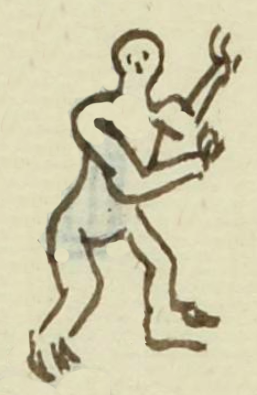Tzicuin (MH658v)
This black-line drawing for the simplex glyph for the personal name Tzicuin (“Leaper” or “Runner”) shows a nude man in a three-quarter view. He has his arms raised, his knees slightly bent, and his legs somewhat apart, as though he is about to jump or run.
Stephanie Wood
The verb choloa has a similar meaning of running or jumping, but it can also lean toward “flee” and refer to people who had left a pueblo to avoid paying tribute. In the Codex Mendoza choloa was typically shown with a bent deer leg, but by the time of the Matrícula de Huexotzinco, it could appear as a human leg or footprints. It is a more common verb than tzicuini in Nahua hieroglyphs.
The way this man is shown in a 3/4 view may suggest European artistic influence.
Stephanie Wood
andres.tzicuī.
Andrés Tzicuin
Stephanie Wood
1560
Jeff Haskett-Wood
saltar, correr, nombres de hombres

tzicuini, to leap, jump, or run, https://nahuatl.wired-humanities.org/content/tzicuini
Saltó
Stephanie Wood
Matrícula de Huexotzinco, folio 658v, World Digital Library, https://www.loc.gov/resource/gdcwdl.wdl_15282/?sp=397&st=image
This manuscript is hosted by the Library of Congress and the World Digital Library; used here with the Creative Commons, “Attribution-NonCommercial-ShareAlike 3.0 License” (CC-BY-NC-SAq 3.0).






